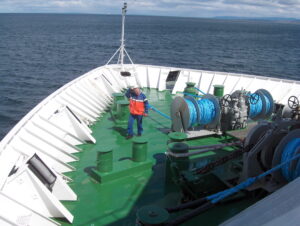Archive for December, 2020
» posted on Friday, December 25th, 2020 by Linda Lou Burton
That Old Time Rock and Roll
 Christmas in Antarctica originally posted by Linda Lou Burton December 25, 2005 from Port Foster, Deception Island, Antarctica – Kiddies all over the world spend Christmas afternoon playing with their new toys, or scowling about their new sweater from Auntie Marge, wondering why she didn’t send something they really needed, that is, electronic. The kiddies on our ship spent the afternoon inside a volcanic caldera. I don’t know how many of them went ashore, but even if they didn’t, it was a beautiful sight. Myself, I viewed it from the ship but offer photos taken by the crew.
Christmas in Antarctica originally posted by Linda Lou Burton December 25, 2005 from Port Foster, Deception Island, Antarctica – Kiddies all over the world spend Christmas afternoon playing with their new toys, or scowling about their new sweater from Auntie Marge, wondering why she didn’t send something they really needed, that is, electronic. The kiddies on our ship spent the afternoon inside a volcanic caldera. I don’t know how many of them went ashore, but even if they didn’t, it was a beautiful sight. Myself, I viewed it from the ship but offer photos taken by the crew. 
We came into this great natural harbor through a 200-meter-wide entrance known as Neptune’s Bellows, for the winds which often howl through. Once inside, perfect calm. We anchored at Port Foster, the name given the waters inside ring-shaped Deception Island. A volcanic caldera! The last eruption was 1970, and most of the damage done was due to a massive mudslide. Home to British, Norwegian, and Australian whalers or researchers at various times during the past, it’s mostly a tourist stop now.
Main attraction: swimming! Steam vents from the volcano offer waters warm, bubbling from the black volcanic sands. Did our contingent swim today? Ya, you betcha! Ten brave and hardy souls came back bragging, grinning big, the Australians, we are told.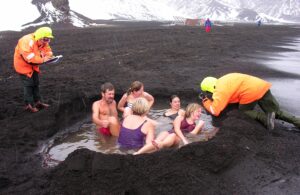
Coffee and Christmas cakes on Dekk 7, to celebrate. Then time to leave. The ship moved out into Bransfield Strait, then on to Gerlache, headed towards the Antarctic Peninsula itself. We hit open waters, during the dinner buffet.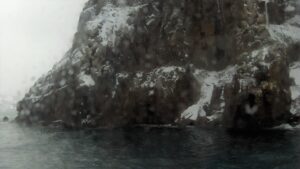
The ship swayed left, the ship swayed right. Passengers with plates full of pickled herring grabbed the railing, knees buckled, hang on tight. The servers managed better, more accustomed to the movements of the ship. Still, there was a crash, a stack of glasses broke against the floor.
I had my wristbands on, pressing tight against the acupressure point. Do not get seasick, I told myself. We laughed at each other, “Get the fork into the mouth. Don’t miss!” The water sloshed back and forth inside our glasses. Some bites of bread, that is all I wanted. “It’s better to be seasick with your stomach full,” I’m told. I ate some more.
My room. That is where I wanted to be. I grabbed the handle of the dining room door, went hand to hand from rail to rail. To the stairway, down one floor. The hallway to my room is fitted with good railing, which I held to tightly.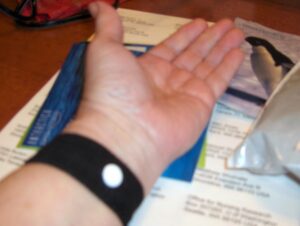
There’s the bed. I am there now. And there I stay. Rock and roll. Burp.
» posted on Friday, December 25th, 2020 by Linda Lou Burton
Manuel and the Hoochy Coochy
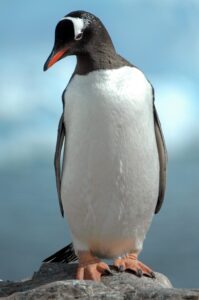 Christmas in Antarctica originally posted by Linda Lou Burton December 25, 2005 from Hannah Point,
Christmas in Antarctica originally posted by Linda Lou Burton December 25, 2005 from Hannah Point, 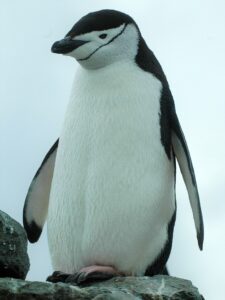 Livingston Island, Antarctica – Christmas Day! We wake up at Hannah Point, known as the “jewel in the crown” of the Antarctic for its diversity of species and glorious scenery. Named for the Hannah, a sealing vessel, it is home to three species of penguins — Gentoo with their striking orange beaks, Chinstrap with a “strap” of black feathers under their chin, and Macaroni with their yellow rock-star hairdo.
Livingston Island, Antarctica – Christmas Day! We wake up at Hannah Point, known as the “jewel in the crown” of the Antarctic for its diversity of species and glorious scenery. Named for the Hannah, a sealing vessel, it is home to three species of penguins — Gentoo with their striking orange beaks, Chinstrap with a “strap” of black feathers under their chin, and Macaroni with their yellow rock-star hairdo.
The clouds have moved in today, the temperature has dropped to 33 F, and, to the delight of many who have never had a White Christmas, it is snowing! A light snow, faintly blowing across the deck, but snow, nonetheless.
For certain, I will enjoy the delights of Antarctica from the warmth of the Torghatten Salong today, sitting in a comfy chair with cameras occasionally recording the magnificent view.
And, writing. There is a contest! Manuel Marin has challenged us. Manual is part of our lecture/teaching staff, an Ornithologist from Chile (PhD from LSU!), a researcher of neotropical birds. So far, his lectures have included: Cormorants, the Untold Story; Penguins, Those from the other side; Penguins, The brush-tailed, Life and Death Part 1; Penguins, The brush-tailed, Life and Death Part 2. Manuel knows penguins. His lectures are  entertaining: he passes around penguin parts for us to see (see the foot, they are very sharp!); he giggles as he shows us slides of penguins mating (ooo, Triple X, ladies cover your eyes!). “Pebbles are like diamonds,” he explains, describing a penguin nest. “The male offers a pebble to a female during the courtship ritual. These are of utmost value! Better than chocolates! Better than Chanel #55! So good!”
entertaining: he passes around penguin parts for us to see (see the foot, they are very sharp!); he giggles as he shows us slides of penguins mating (ooo, Triple X, ladies cover your eyes!). “Pebbles are like diamonds,” he explains, describing a penguin nest. “The male offers a pebble to a female during the courtship ritual. These are of utmost value! Better than chocolates! Better than Chanel #55! So good!”
Without the pebbles, there is little protection for the egg. A pile of pebbles makes for good drainage too. An egg left sitting on bare ground is more likely to freeze, or crack. “You think it is OK to take one pebble home?” Manuel asks us, looking stern, searching for a guilty face. “You think one pebble will not matter?” A pause. “Twenty-four thousand visitors came to Antarctica last year. If each person took ONE PEBBLE, what would happen to the beach! What would happen to the penguins! Do not take the pebbles! Do not pick up the feathers! If you promised this to your grandchild, instead, tell your grandchild how you helped a penguin to have life! You saved the egg!”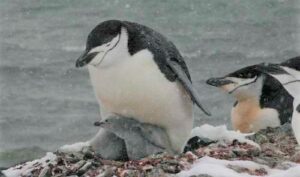
Manuel paced around the room. Did he make his point? Still, Manuel wants us to think more. To understand the penguin. So, now there is a contest. All around the ship he posted signs, in English and in German.
Contest!
Prizes for drawing, sculpture, poem about birds!
Deadline December 28!
Pamela has been working on a cross-stitch penguin piece, sitting in her favorite chair each 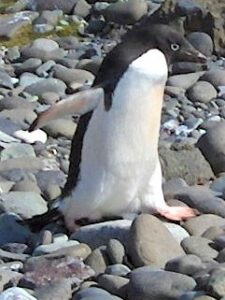 day near the cakes and tea, beside the “cleanest window,” she reports. Doug sits near there too, his watercolors spread on the tabletop, brushing daily memories onto paper. I’m sure he’ll have a beautiful bird to submit.
day near the cakes and tea, beside the “cleanest window,” she reports. Doug sits near there too, his watercolors spread on the tabletop, brushing daily memories onto paper. I’m sure he’ll have a beautiful bird to submit.
I can’t sew, or paint. But I like to write. Especially humorous takeoffs on the Night Before Christmas, at least, at Christmas time. Hmmmm, I’m thinking, as I see the penguins walking, far away, along the beach. In my mind I see the little Adelie penguin who passed me by the day before, hobbling and hopping over the rocks, her tiny wings an afterthought by her creator? Penguins. They can swim, but they can’t fly. What might a penguin wish for? I began to scribble, on a yellow pad…
- ‘Twas the night before Christmas, and all through the ship, every creature was stirring, celebrating their trip!

- But the penguins were nestled, all snug on their nests, having spent the day hosting, the Nord-nor-gay as guest.
- Adelie and gentoo, they welcomed our walk, enduring the kameras, with barely a squawk.
- On came Evie and Stevie, on came Lily and Luke, with a flap and a waddle, then the Duchess, and Duke.
- With pebbles like diamonds, all piled in a stack, each went for their lunch, and then each came back.
- No dishes to wash, no laundry to do, the life of a penguin, seems all lovey, and woo.
- When the spring light first came, and the weather got dandy, the Lukes and the Lilys, began to get randy.
- Hey baby! They called, You are looking so fine, take this pebble of love, and you can be mine.
- Oh hoochy! Oh coochy!, Stand still! I’ll be quick. But Lily is fickle. Did Luke give her a chick?
- Footprints on her back, show she’s tried it before. It’s only insurance! Our sweet Lily’s no whore!
- The wedding is over, the nest is complete. Lily sits like Queen Sheba, piles of rocks at her feet.
- Luke stands guard for the skua, They both watch for the seal. The egg and the instinct are honored, with zeal.
- Some penguins are jealous, They had no such luck. They sneak to steal pebbles. They fuss, and they cluck.
- But Lily is fearless and Luke remains cool. The egg is kept warm. It’s their asset, their jewel.
- Peck Peck! I want out! Little chickie appears. Papa checks chickie’s feet, Mama checks chickie’s ears.
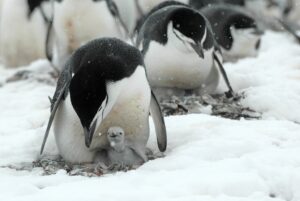
- Lily Penguin suggests, Let’s name our boy Lars. Papa Luke puffs his chest as he hands out cigars.
- Luke and Lily soon learn to their major surprise, now that chickie is born no more closing their eyes.
- Peep Peep! I want food! Bring me something to eat! Luke and Lily grow weary, nearly dead on their feet.
- Soon Lars becomes fuzzy. A mass of gray fat. Luke and Lily agree, That’s enough now, of that.
- So Lars learns how to swim. How to catch his own krill. Lars doesn’t mind that, but he dreams bigger, still.
- For the one thing he sees as the days pass on by, are the birds with big wings, soaring high in the sky.
- He stands on a rock, he jumps with a flap, but the beach comes to meet him, and he lands with a blap!
- He tries and he tries it. He jumps and he wishes. He thinks not of krill. Or even of fishies.
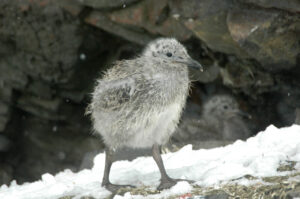
- I KNOW I can do it! I know there’s a way! I want to look down, on the ice, and the bay.
- The other chicks mock him. Even Lily and Luke wonder what they did wrong. Why is their boy a fluke?
- Now Christmas Eve’s here. Lars is sleeping, and dreaming. And Santa is near, hearing wishes, and scheming.
- Then, while the ship parties, drinking, eating, and singing, Santa stops on a glacier, sleigh bells tinkling and ringing.
- Come here Lars! He says quickly, Come and get in my sleigh, I will take you up flying, Up up up, and away!
- More rapid than skuas, his coursers they flew, and Lars knew at that moment, heartfelt wishes come true!
- The penguins below, saw Lars wave from his flight, as he called, “Happy Christmas! And to all, a Good Night!”
I decided to hand it in. I named it “The Rime of the Misunderstood Penguin,” with a special Cootchy-Coo Dedication to Manuel Marin.
Wish me luck!
» posted on Thursday, December 24th, 2020 by Linda Lou Burton
God Jul / Frohe Weihnachten / Feliz Navidad
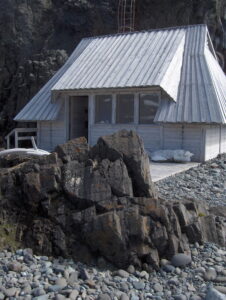 Christmas in Antarctica originally posted by Linda Lou Burton December 24, 2005 from Discovery Bay, Greenwich Island, Antarctica – I’ve never had a Christmas Eve like this one. A morning landing in Admiralty Bay, a meeting of the penguins, a talk with Mario, who is stationed at Poland’s Arctowski station for the next year. “I learned English from the TV,” he told me, apologizing frequently when he couldn’t remember a word he wanted to use. He is studying glaciers, sedimentation. “But travel is my passion,” he confessed. He told me of all the places he has already been, this slender young man of no more than twenty-five. We talked about our Christmas traditions. “The Americans from Copacabana Station are coming tonight for a Christmas Eve party,” he said. “Today, we cannot eat meat, only fish, but tomorrow we will have turkey.” We stood on the deck of the tiny wooden hut under the lighthouse, whale bones strowed around, penguins waddling by, icebergs floating near.
Christmas in Antarctica originally posted by Linda Lou Burton December 24, 2005 from Discovery Bay, Greenwich Island, Antarctica – I’ve never had a Christmas Eve like this one. A morning landing in Admiralty Bay, a meeting of the penguins, a talk with Mario, who is stationed at Poland’s Arctowski station for the next year. “I learned English from the TV,” he told me, apologizing frequently when he couldn’t remember a word he wanted to use. He is studying glaciers, sedimentation. “But travel is my passion,” he confessed. He told me of all the places he has already been, this slender young man of no more than twenty-five. We talked about our Christmas traditions. “The Americans from Copacabana Station are coming tonight for a Christmas Eve party,” he said. “Today, we cannot eat meat, only fish, but tomorrow we will have turkey.” We stood on the deck of the tiny wooden hut under the lighthouse, whale bones strowed around, penguins waddling by, icebergs floating near.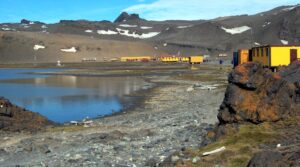
It was time for me to go. “Can I hang onto your back?” I asked when I spotted my shipmates passing by. Pamela was having no problem walking, so John offered his arm to help me over the rocks. “Goodbye Mario,” I said, “Merry Christmas!”
Back on the ship, I slept for hours. I missed the briefing, missed the stop at Aitcho Islands. The Aitchos were named for the British Admiralty Hydrographic Office, or, H. O. In the English Strait between Robert and Greenwich Islands, it’s a beautiful spot with sheer cliffs and spires, huge, green moss beds, and nesting Gentoo and Chinstrap penguins. I was sorry I missed the trip ashore, but glad I was rested for the evening.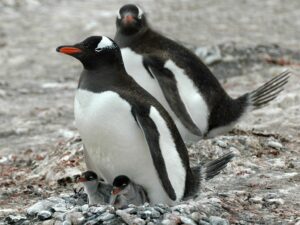
Yuletide celebration on Dekk 7 at 7:15, the announcement said. Wearing red and green, I arrived on time. Mulled wine, Christmas carols sung in German, English, Silent Night; then sung all languages together; O Tannenbaum! I knew the makeup of the guests – 51 Germans, 42 Australians, 24 Americans, 11 British, 9 Dutch, 9 Norwegian, 7 Italian, 5 Swedish, 4 French, 3 Austrian, 3 Chilean, 2 each from Belgium, Denmark and Israel, and 1 each from Canada, Portugal, Slovakia, and Switzerland. Did the music bring us closer? I don’t know. I know that it was memorable.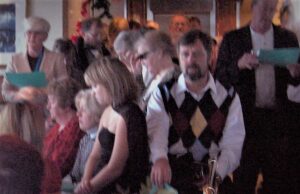
From there to the dining room, Dekk 4. At the front of the room, the Captain stood, Bible in hand. “It is tradition,” he said, “for the Captain to read the Christmas story in Norwegian. Then it will be read in English, in German, and in Spanish.” He began to read, the room stilled, the Christmas tree near my table glittered with candles. I pointed the videocam to catch his reading; kept it running through the English too. Icebergs floated by outside.
Then food! Turkey, roast pork, fish of every kind. Salads, Norwegian smorgasbord. A table arrayed with cakes, candies, a yule log with a mouse on top. So much to eat, and penguin decorations too, reminders of our special day.
Then bells began to ring. The children in the crowd looked up as three Santas burst through  the door, dark-skinned Filipino crew with stringy cotton beards, laughing, toting bags. The children ran back and forth, laughing too. Our Santa stopped with packages for each of us, wrapped in green. The four of us at Table 2 eyed one another, couldn’t wait. I opened mine, and so did they. Flashlights! The mini-kind, so perfect for your pocket, or your purse. We shined the lights at one another’s faces, just like kids would do.
the door, dark-skinned Filipino crew with stringy cotton beards, laughing, toting bags. The children ran back and forth, laughing too. Our Santa stopped with packages for each of us, wrapped in green. The four of us at Table 2 eyed one another, couldn’t wait. I opened mine, and so did they. Flashlights! The mini-kind, so perfect for your pocket, or your purse. We shined the lights at one another’s faces, just like kids would do.
Tired now, at 10 PM. But light outside, the icebergs morning white. I’m typing now, to you.
Happy Christmas! God Jul! Frohe Weihnachten! Feliz Navidad!
» posted on Thursday, December 24th, 2020 by Linda Lou Burton
Christmas Eve with Evie
Christmas in Antarctica originally posted by Linda Lou Burton December 24, 2005 from Arctowski Station, Admiralty Bay, King George Island, Antarctica – Today is Christmas Eve, and I have walked Antarctic soil. The first announcement on the information speaker at 7:30 was this: “I will no longer comment on the weather. This is silly!” Our expedition leader was awed by our good fortune – clear skies, calm waters, 41 degrees.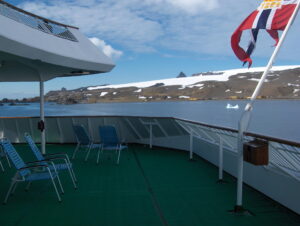
At breakfast, I asked the question. Surely I won’t need my longjohns? Surely not the wool sweater? “Da wetter kud change,” Will admonished me. “Take da swetter!” I was sitting at the table with Will and Paul and Annemarie and their parents, who were chatting away in Dutch with an occasional English comment thrown in for me. I asked Paul what a typical Dutch breakfast would be. He pointed to examples in his plate as he explained it would be sandwich-like, with ham and cheese and vegetables. “What about cereal?” I inquired. “Yes, corn flakes, with sugar already on.” “Frosty flakes?” I said. “Yes!” he laughed. “And chocolate too,” threw in Annemarie. “Cocoa puffs?” I replied. “Yes! Cocoa puffs and chocolate milk!”
 I finished my omelet and sausages, said goodbye, and headed for my room. Time to waterproof. Long underwear, check. Fleece pants, check. Wool socks, check. Wool sweater, check. Waterproof pants next, zipping right, zipping left, Velcro at the bottom. Waterproof bag for cameras into the pack. Fleecy hat, scarf, gloves. Waterproof mittens. Now I rattled when I walked, screech screech, screech, screech. I could not be a spy.
I finished my omelet and sausages, said goodbye, and headed for my room. Time to waterproof. Long underwear, check. Fleece pants, check. Wool socks, check. Wool sweater, check. Waterproof pants next, zipping right, zipping left, Velcro at the bottom. Waterproof bag for cameras into the pack. Fleecy hat, scarf, gloves. Waterproof mittens. Now I rattled when I walked, screech screech, screech, screech. I could not be a spy.
I headed for Dekk 7 to watch the first group leave. The crew had gone first with supplies — set up with enough water and shelter to keep those on shore safe for 24 hours should a sudden storm arise.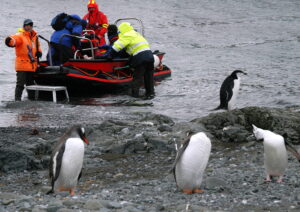
We were divided into six groups, names posted on the wall like a playground list at school. Group 1 is first on the first excursion, followed by Group 2, and so on. Next excursion, Group 2 is first, followed by Group 3, and Group 1 will be last! So, everyone gets a turn to go first. This was explained to us carefully, watching our faces, hoping, I guess, that we wouldn’t be quarrelsome and whiny. I was in Group 6, this was the third excursion for the trip, so, hence, therefore, I would be on the fourth boat today??
“Group 6 may proceed to the Departure Dekk!” was finally called. I scurried down to the boot room, filled with stacks and rows of black rubber Wellies, size clearly handpainted in yellow on the back. I found some 8’s, hoping the fit over the wool socks would work. Puff puff pant pant struggle on with the boots. Into the next room, blop blop blop blop. I was handed a life jacket, helped to adjust it over my Nordic blue Antarctica Voyage of Discovery waterproof, windproof parka. Then fumble through all the layers to find my ID card. Beep, scan me through, officially checked out. Next onto the disinfectant sponge (no germs allowed on shore in the penguin rookery), through the spraywash for the boots, to the ship’s door. Narrow steps, rope for railing, blop blop blop blop to the PolarCirkel boat. I was the last one in.
It was a beautiful ride, five minutes across to Arctowski Base, the hillside above our landing site covered with penguin rookeries. We were not allowed anywhere near the rookeries; our orders were to stick to the path to the Base and allow penguins to come to us.
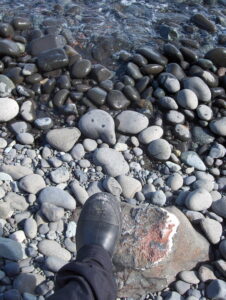 Landing, grab the PolarCirkel rails, step to a metal step perched perilously in the rocky waters. “Jump!” I was told. I jumped, splashed in clear water nearly to my knees. Aha! My well-baptized feet are in the Southern Ocean! But I cannot reach my camera, cannot even walk. A gentleman behind offers his arm. I take it, gratefully, and climb the rocky bank. On shore, I realize I will not be able to walk to the Base, a mile or so away. The rocks are too big, too rough for my uncertain hobble-walk. My feet are slipping inside the Wellies, blop blop blop. I analyze my options.
Landing, grab the PolarCirkel rails, step to a metal step perched perilously in the rocky waters. “Jump!” I was told. I jumped, splashed in clear water nearly to my knees. Aha! My well-baptized feet are in the Southern Ocean! But I cannot reach my camera, cannot even walk. A gentleman behind offers his arm. I take it, gratefully, and climb the rocky bank. On shore, I realize I will not be able to walk to the Base, a mile or so away. The rocks are too big, too rough for my uncertain hobble-walk. My feet are slipping inside the Wellies, blop blop blop. I analyze my options.
“Manuel tells you there are 17 species of penguin,” our leader had said in an earlier briefing, following a lecture by our resident penguin researcher. “But I say there are two. Black penguins, and white penguins. If you see penguins, and run towards them shouting Look Look Penguins!, then you will see nothing but black penguins. If you see penguins, and stand very still, patiently waiting for them to come to you, then you will see white penguins.”
 OK, I decided, as my eyes scanned the rocky shore, I will stand very still. Maybe the penguins will come to me. Patience pays.
OK, I decided, as my eyes scanned the rocky shore, I will stand very still. Maybe the penguins will come to me. Patience pays.
A single penguin came around a rock, hobbling, wobbling, struggling even more than me on the uneven ground. Balancing her flippers sideways, left, right, left, right, she reached the top of our little ridge and looked around. More rocks ahead. An uneven walk to the beach, and lunch.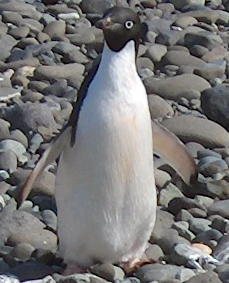
Evie looked up at me. I looked back at Evie. We looked at the hateful rocks together. “ohrmmph” she said, with a shake of her head. “That’s a long walk!”
I knew what she meant. She looked at me again, her white-ringed eyes unblinking and clear. Then she shook her head, flapped her flippers in a get-started motion, and hobbled across the rocks to the ocean shore.
You go, girl.
» posted on Wednesday, December 23rd, 2020 by Linda Lou Burton
Get Ready for Jeopardy!
 Christmas in Antarctica originally posted by Linda Lou Burton December 23, 2005 from Southern Ocean, Antarctica – When I told people I was going to visit Antarctica, responses varied from “Where is that?” to “Why would you want to do something like that?” to “What will you DO there?” to “It will be mighty cold there.” It’s like humor, I guess, if you have to explain it to someone, you know they will never get it anyhow! The people I’m traveling with on this ship are of one mind about Antarctica – they love it, are awed with it, and would come back in a minute.
Christmas in Antarctica originally posted by Linda Lou Burton December 23, 2005 from Southern Ocean, Antarctica – When I told people I was going to visit Antarctica, responses varied from “Where is that?” to “Why would you want to do something like that?” to “What will you DO there?” to “It will be mighty cold there.” It’s like humor, I guess, if you have to explain it to someone, you know they will never get it anyhow! The people I’m traveling with on this ship are of one mind about Antarctica – they love it, are awed with it, and would come back in a minute.
Now you, take a peek at the bottom end of your World Globe, and get your gourd ready for a game of Jeopardy.
Some things to know about Antarctica, AKA, The Ice, gleaned from Alan Parker’s lecture on Antarctica, and my Lonely Planet book. (2020 update: Alan Parker died July 26, 2020. I am pleased I was privileged to hear him speak in 2005.)
- Antarctica has no wars.
- Antarctica’s environment is fully protected.
- Antarctica is a nature reserve devoted to peace and science.
- Antarctica has no native population.
- Antarctica has no native government; no country holds title over any part of it.
- Antarctica is governed by the Antarctic Treaty, with 45 member nations, who meet annually to discuss scientific cooperation, environmental protection, management of tourism, and preservation of historic sites.
- Antarctic residents are temporary; people come to work in Antarctica from dozens of countries.
- Antarctica’s winter population is about 1,200 – one-third scientists and the rest support personnel; summer population is about 7,200.
- Antarctica was visited by over 13,000 tourists in 2003 – 40% from the US, 15% each from Germany and the U. K., 6% from Australia, and 3% each from Japan, Canada and Switzerland.
- Antarctic tourism is controlled by IAATO, International Association of Antarctica Tour Operators, and limits visitors to 100 at any place at any one time.
- Antarctica is the world’s most arid continent.

- Antarctica is the world’s highest continent.
- Antarctica is 99.6% covered by ice.
- Antarctica’s Lambert Glacier is the largest glacier in the world.
- Antarctica’s Ice Sheet is 1.4 times the size of the United States.
- Antarctica’s Ice Sheet contains 70% of the world’s fresh water.
- Antarctica’s ice is so thick, accumulating over millions of years, that its weight pushes the land mass underneath below sea level.
- Antarctica’s Ice Sheet melts very little, even though it has constant sunrays during summer months, because the sun’s heat is reflected back by the ice.
Question please?
» posted on Wednesday, December 23rd, 2020 by Linda Lou Burton
From the Bridge
Christmas in Antarctica originally posted by Linda Lou Burton December 23, 2005 from Drake Passage, Antarctica – We entered the Southern Ocean a few hours ago. AKA the Convergence Zone. The Drake Passage is the Drake Lake today. Sometimes, I’m told, it is the Drake Shake. When that happens, you pay your Drake Tax. I’m wearing my acupressure wristbands to avoid seasickness, even though the roll is gentle. Like the man waving the stick to keep the elephants away, it’s working!
Since there is nothing to look at today but water, water, everywhere, our leader has planned events to keep us busy. Morning, a trip to the Bridge. Then, lectures.
- Penguins: The brush-tailed – Life and Death Part II, by Dr Manuel Marin
- The Antarctic Frigid Zone – Why is it so?, by Alan Parker
- Heroic Hearts: Amundsen and Scott, by Ian Shaw
And of course, our Pre-landing briefing at 6 PM.
The Happy Hour drink today is Planter’s Punch, and the phrase of the day is “Are you cold? Er du kald? Ist Dir kalt? Tienes frio?”
I want to hear Alan Parker’s lecture today. Alan has made 56 trips to Antarctica, been awarded a Polar Medal for his contributions to science in Antarctica, and even has a mountain named for him! Parker Peak. A native of Australia, he has lived on Macquarrie Island for a 12-month stint, and worked at Davis Station for fifteen. Who better to listen to for learning more about Antarctica?
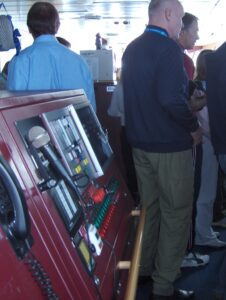 But about the water now: according to my handout, the Antarctic Convergence is where the warmer waters of the north meet the colder, denser, less saline waters of the south. Colder water sinks, of course, causing an up-welling that brings nutrients to the surface. This point, which is ever-changing, is the biological limit of the Antarctic ecosystem. There is no way to know when you cross it except by thermometer. But, I am assured by the second-in-command on the Bridge, we have passed it now. Our Captain is busy shaking hands, greeting visitors, smiling at us all.
But about the water now: according to my handout, the Antarctic Convergence is where the warmer waters of the north meet the colder, denser, less saline waters of the south. Colder water sinks, of course, causing an up-welling that brings nutrients to the surface. This point, which is ever-changing, is the biological limit of the Antarctic ecosystem. There is no way to know when you cross it except by thermometer. But, I am assured by the second-in-command on the Bridge, we have passed it now. Our Captain is busy shaking hands, greeting visitors, smiling at us all.
More facts. The Convergence Zone, this Polar Front, is a function of the Antarctic Circumpolar Current. The waters of Antarctica circle the continent in the world’s biggest ocean current at an estimated rate of 150 million cubic meters per second! That’s  equivalent to FOUR GULF STREAMS or ONE THOUSAND AMAZON RIVERS! As this dense water begins to move north, it has tremendous impact on global weather systems. Carried into the Atlantic and Pacific Oceans, it has a cooling effect on tropical and temperate waters, very important to the oceans’ balance.
equivalent to FOUR GULF STREAMS or ONE THOUSAND AMAZON RIVERS! As this dense water begins to move north, it has tremendous impact on global weather systems. Carried into the Atlantic and Pacific Oceans, it has a cooling effect on tropical and temperate waters, very important to the oceans’ balance.
I’m impressed! “Exactly where is it considered the point where the Atlantic and Pacific meet?” I asked. A shrug. “I don’t know,” was the reply, “perhaps at Cape Horn?”
This is humorous to me. I picture the ship pointed south from Cabos de Hornos, riding a fine dotted line with Atlantic left, Pacific right, then, blip, another hop into Southern Ocean waters.
» posted on Tuesday, December 22nd, 2020 by Linda Lou Burton
Sound the Trumpets! Mission Accomplished
Christmas in Antarctica originally posted by Linda Lou Burton December 22, 2005 from Cape Horn, Chile – I’d had my fingers crossed since June 22 and the trip to Barrow, Alaska, where I was NORTH of the Arctic Circle on the first day of Summer. There didn’t seem to be any way possible to get myself SOUTH of the Antarctic Circle on the first day of the southern hemisphere’s Summer, because nobody GOES there. But Cape Horn would do. The southernmost point of what is considered South America, Latitude 55.43 degrees south. Barrow was at Latitude 71.19 degrees north and even Fairbanks, Alaska was 64.83 degrees. But hey, the earth is made up of mostly LAND at the north end and mostly WATER at the south. So be it. Cape Horn would satisfy me. I wanted to set my foot on that chunk of land on December 22.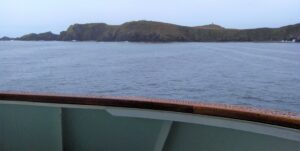
We had come through the Beagle Channel to arrive at the Horn at 2:30 PM, and our leader announced with great glee, “We can land!” In the last fifteen crossings, he told us, the weather had been fit for a landing only three times. He was jumping around, PREPARING things. I did my analysis too. The sea didn’t look too rough, the rain wasn’t coming down too hard, the distance to shore wasn’t too far. But then.
I zoomed in on the steps. The shoreline was rocky, the landing beach quite small. A sheer rock cliff rose straight up from the beach, and that’s where the steps were, fastened somehow to the rock wall. One hundred and twelve rickety wooden steps, some broken or split, all slippery in the waves and rain.
Just at the top on a rounded grassy knoll I could see the monument to the albatross, honoring all the sailors who perished while trying to round the cape. Sara Vial’s poem was inscribed at the bottom of the monument, I read from our handout:
“I am the albatross that waits for you at the end of the earth. I am the forgotten soul of the dead sailors who crossed Cape Horn from all the seas of the world. But they did not die in the furious waves. Today they fly in my wings to eternity in the last trough of the Antarctic winds.”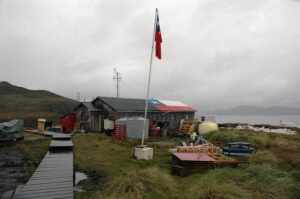
A few hundred yards left of the monument was the the home of the lighthouse keeper, supposedly occupied by the keeper, his wife, a cat, and a dog. A lonely existence! “There may be souvenirs available from there,” we were told, “but be patient, the house is very tiny.”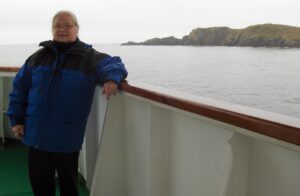
Reluctantly, I decided not to make the trip. I’d consider my Mission Accomplished by my presence on the ship. I spent the day in the Torghatten Salong, with my cameras and 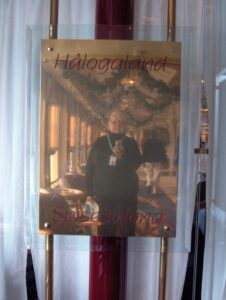 with many others who didn’t want to venture up those steps. I walked in the open air of Deck 5. “Will you take my picture with the Cape behind me?” I asked one of the stay-behinds. She did.
with many others who didn’t want to venture up those steps. I walked in the open air of Deck 5. “Will you take my picture with the Cape behind me?” I asked one of the stay-behinds. She did.
That evening, at dinner, those who braved the climb relayed their story. “I have a certificate!” they said. “I have walked on Cape Horn!”
Well, I’ve been close. “Cape Horn is one of the greatest graveyards for ships anywhere in the world,” were the words on my handout. “It is a rite of passage for sailors the world over.” “Aha! My rite of passage,” I thought. “I have rounded the Horn.”
Overall, I’m pretty pleased. First Day of Summer, I declare you a success.
» posted on Monday, December 21st, 2020 by Linda Lou Burton
El Poocho and the Sunny Day
Christmas in Antarctica originally posted by Linda Lou Burton December 21, 2005 from Punta Arenas, Chile – Sometimes, things just can’t get any better. The engine noises this morning sounded different. That’s what woke me up. A peep out my bigger-than-a-porthole window gave me two surprises. We had just docked at the Punta Arenas pier, and, the sun was shining!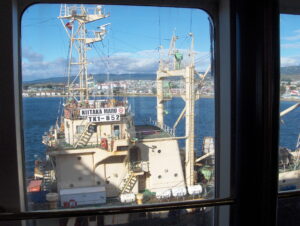
We’d been instructed at the briefing the evening before that our buses would depart from the other end of the pier by 8:30 AM. The sedge-ool was tight, we were warned. The ship had to leave at 3 PM. We’d also been warned about something else. “This is a military pier, so don’t be taking photographs as you walk to the end of it. Utter-vise, you vill be shot unt da bak!” our leader promised.
I had carefully laid out my clothes the night before, so it didn’t take me long to get myself ready to roll and up to the dining room. The eggs were fried today, and I nibbled on some eggwhite and a piece of toast. Should we take our windbreakers, my tablemates pondered? “I always say,” I said to Pamela, “take it, you don’t have to wear it!” We settled on that.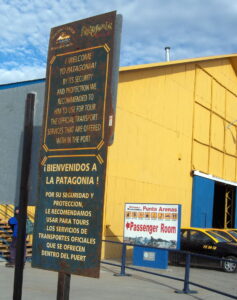
Deck 3, the Security Bar Code Scanner was ready for us. I checked myself out and began the dangerous Walk of the Pier. No military presence was apparent, just a Japanese ship unloading cargo and the Australian Antarctic Dream. I entered the gold CUSTOMS building at the other end and browsed the postcards and knitted woolens. It was only 8:10, and a pleasant 51 degrees.
Needing no woolens, I exited the building in search of my bus. Nordnorge Fitz Roy English was the one I needed. Another bus headed for the Fitz Roy was identified as German. Three buses were chartered for the Otway Penguin Colony. I figured I would see enough penguins in Antarctica. The Fitz Roy promised sheep, and a barbecue!
 “Hi, I am Patricia!” a smiling tour guide greeted me at the bus. I chose a window seat and piled my things around, settling in for the two-hour ride. Patricia told us about Punta Arenas as we drove through the quiet early morning streets. “The children are on summer holiday,” she explained, “and the businesses do not start so early.” She pointed to monuments, buildings of importance, streets, trees. “It is very windy here,” she said. “There are ropes around town that you can hold onto to keep from being blown down some days.” She explained the history of the area, the industry, the recreation. Punta Arenas is capital of the Magallanes region, on the Strait of Magellan at latitude 54 south. It has a population of 140,000.
“Hi, I am Patricia!” a smiling tour guide greeted me at the bus. I chose a window seat and piled my things around, settling in for the two-hour ride. Patricia told us about Punta Arenas as we drove through the quiet early morning streets. “The children are on summer holiday,” she explained, “and the businesses do not start so early.” She pointed to monuments, buildings of importance, streets, trees. “It is very windy here,” she said. “There are ropes around town that you can hold onto to keep from being blown down some days.” She explained the history of the area, the industry, the recreation. Punta Arenas is capital of the Magallanes region, on the Strait of Magellan at latitude 54 south. It has a population of 140,000.
Soon we were at the edge of town, on Highway 9 headed north, with the sun shining on Estrecho de Magallanes to our right. Patricia told us about the plants and the animals of the region. The driver pulled to the side of the road so we could see the nandu, mother and baby, feeding in the bushes. Nandu is very like ostrich. The driver stopped again to show us guanaco (llama-like), and condor flying overhead.
After a while we turned onto a highway-like graveled road, headed west now, towards Isla Riesco. “We will cross on the ferry there,” Patricia explained, “to get to the Fitz Roy.”
The ferry was just long enough to fit one bus. The waters from Seno de Skyring and Seno Otway funneled through a narrow channel here, with Isla Riesco across the way. Many of us departed the bus for photos as we waited while the wind blew the ferry one way, the engines brought it back to another for alignment. Several fishing boats rested by the landing, the fishermen busy with their morning chores. Finally the bus was on, we stepped across the metal ramp, and off we went. The wind was sharp, but the waves showed no white, only brilliant blue.
Five minutes to cross. Signs there, Sector Nord, Sector Sud, listing all the farms. Back on the bus, we headed south. We climbed the hill on a narrow gravel road. The waters of the Seno were all around, and flowers colored the low-growth sage as far as you could see with purples, pinks, and yellows. Lupine! Scotch Broom! Through a gate now, over a cattle stop, I see some buildings down ahead.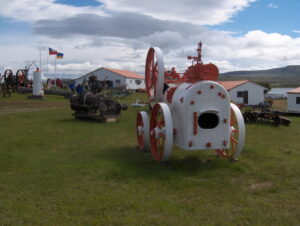
Estancia Fitz Roy is owned by the Fernandez family. I do not know how many acres, but the land slopes to the waters, the wind is constant, it is perfect for raising wooly sheep. The buildings are painted white, every roof is orange. The big barn for shearing the sheep is also a museum, filled with tools from other eras.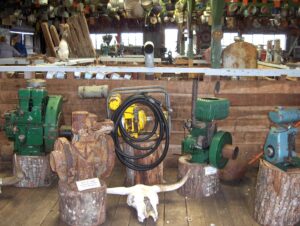
A demonstration is going on, the shearer wears a hat made of wool. He holds the sheep against his chest, her head is angled back, she is resigned. The layers of wool fall to the floor in a pile of dirty gray. The sheep is ready now, for the summer heat.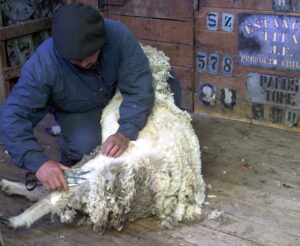
Outside, more sheep wait in the pen. They are dirty gray, not Bo-Peep fluffy white. A black alpaca has been placed inside for calm. His head is higher than mine, he watches to see what I will do. I snap his picture, of course.
A path ahead, a steeple visible through the trees, a cross. Inside the chapel, an altar, the pews are made of logs, split in half and smoothed.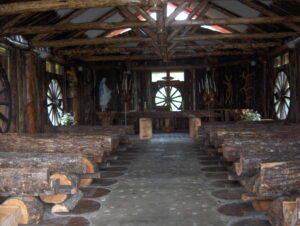
Another path, lined with brilliant yellow bushes, higher than my head. Scotch broom, again. At the end of the path, the smell of food.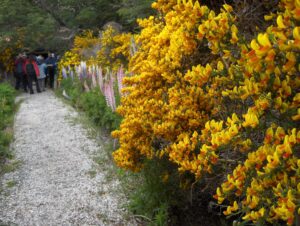
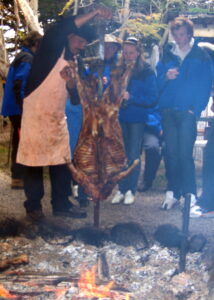 Under a shelter two fires are going. A split of lamb is skewed to a stick beside a pit of fire. A Fernandez family member has a tray, he serves the pisco, strong drink, sour.
Under a shelter two fires are going. A split of lamb is skewed to a stick beside a pit of fire. A Fernandez family member has a tray, he serves the pisco, strong drink, sour.
Inside, another cooking fire, a grill six feet across, lamb is sizzling hot. The room is made of logs, the floor is stone. The large round tables are metal saws, bolted to legs, a strip of metal welded to the edge to cover the sharp; the seats are logs, cut stool-high and padded with wool. Wood stoves scattered around the room, the largest filled with fire, for heat. The others are cold, and serve as tabletops. The food is ready! Bowls heaping with potatoes, peas, green beans, tomatoes, salads. Piles of bread. We take our plates and stand at the grill, to be served the lamb. The Fernandez family circles the room, pouring the Chilean wine, greeting, smiling their welcome.
Outside the window wall another show. Sheep are herded inside the fence, a rider on a horse is in command. The sheep turn this way and that, moving as one, till he decides it is time for them to depart the gate. He calls to the dog to direct, and in a flash, the sheep are gone.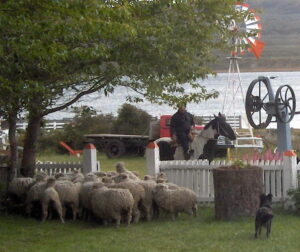
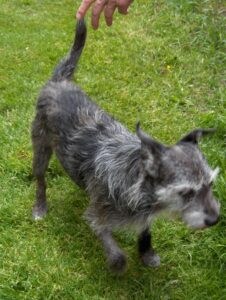 El Poocho. The dog. I’ve read of sheep dogs, collies, intelligent and strong. El Poocho was a mutt. Tiny and gray, more like a terrier, but still a mutt. He owned the farm. He greeted the bus, led the tourists to the barn. He teased the puma in his cage. He told the sheep just where to go, and when. He was friendly. He was in charge! I wandered out, followed him along the lupine path. Stop doggie, stop! I want your picture! Every time I thought he would be still, he lifted his leg to water the plants. Someone clever brought some lamb. Here doggie, here! He stopped to sniff, but did not stay. He barked and ran in circles as we boarded our bus.
El Poocho. The dog. I’ve read of sheep dogs, collies, intelligent and strong. El Poocho was a mutt. Tiny and gray, more like a terrier, but still a mutt. He owned the farm. He greeted the bus, led the tourists to the barn. He teased the puma in his cage. He told the sheep just where to go, and when. He was friendly. He was in charge! I wandered out, followed him along the lupine path. Stop doggie, stop! I want your picture! Every time I thought he would be still, he lifted his leg to water the plants. Someone clever brought some lamb. Here doggie, here! He stopped to sniff, but did not stay. He barked and ran in circles as we boarded our bus.
Senora Fernandez came aboard to bring a gift. Homemade rhubarb jam. Merry Christmas! She said. Across the picket fence, inside the window of her house, I saw a Christmas tree. Outside, the lupine bloomed.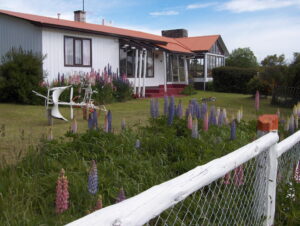
Now, back across the cattle stop, past the hills of sage, down to the ferry stop. The wind was stronger now, the engines could not seem to hold the place, the ferry swayed. A shovel was brought forth, a new path dug. Our driver backed the bus across the new-piled gravel, then the metal ramp, frowning all the while.
I mostly slept as the bus sped back to Punta Arenas, two hours for the ride. Patricia did not talk much, although I asked to see Isla Riesco on the map. She told me of the coal mines there, but did not know what kind of coal. I saw no signs of mining.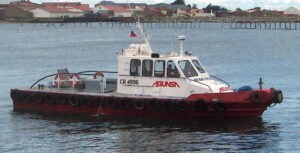
We’re late! The ship was to depart at 3 and it is now 3 PM. The Chilean pilot who guides the ship into the port is waiting for us to leave. Patricia tells us to gather our belongings. “We will drive you to the ship! Get your ID ready!”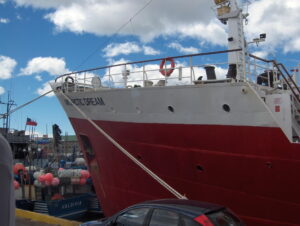
A hurried wave at Customs; the bus zipped along the pier, past the Australian Antarctic Dream, past the Japanese freighter, still unloading cargo. Up the gangplank, beep, I’m coded back onboard.
» posted on Sunday, December 20th, 2020 by Linda Lou Burton
Mah-za-yan-ic Shortcut and My Ed-u-kay-ted Brain
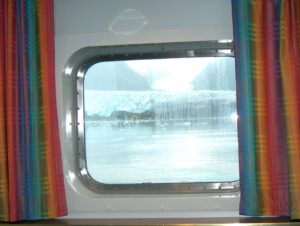 Christmas in Antarctica originally posted by Linda Lou Burton December 20, 2005 from Strait of Magellan, Chile – The alarm went off and I jumped out of bed and peered out the bigger-than-a-porthole window. A chunk of ice went floating by. We were 15 minutes away from the announced destination time at the Skua Glacier, so I splashed cold water on my face and threw on yesterday’s clothes. Two cameras in hand, I headed for Deck 7.
Christmas in Antarctica originally posted by Linda Lou Burton December 20, 2005 from Strait of Magellan, Chile – The alarm went off and I jumped out of bed and peered out the bigger-than-a-porthole window. A chunk of ice went floating by. We were 15 minutes away from the announced destination time at the Skua Glacier, so I splashed cold water on my face and threw on yesterday’s clothes. Two cameras in hand, I headed for Deck 7.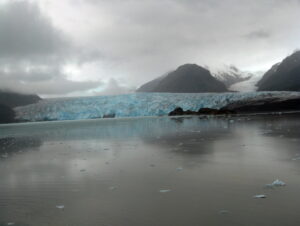
It was cold but not uncomfortable, and a small crowd was gathering, with, like me, cameras in hand. I could see it ahead, at the head of the tiny fjord, a blue glow coming into the sea. Our info described it as picturesque. That it was. I leaned against the rail in the frosty mist and did my photographing thing. Glaciers are blue because the ice is so dense the air has been forced out of them, I’m told. The ship spun three times, slowly, so that even the lazyheads who didn’t want to leave the warmth of their cabins could see. And then we moved out of the fjord and on to Amalia Sound.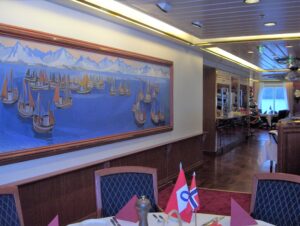
I was catching on to the ship’s routine now. Breakfast. Lectures. Relax by the windows. Watch the world float by, today, still misty with fog. Crepes for breakfast, lots of coffee. A lecture at 9:30 on Patagonia and Tierra del Fuego by Dr Fanz Gingele in Kapp Horn Hall. The Germans have Michael Theusner speaking about Antarktische Wetter and Klima in Nordkapp Hall at the same time.
We have a good lecture staff. Our Expedition Leader is Ian Michael Shaw, Canadian, a youngish, humorous guy, whose credentials claim he “has been beaten up by monkeys on Gibraltar, lived in a Taoist Temple, broken into a Top Secret Naval Base in Vladivostok, tattooed in Tahiti, and sunburned in Brazil.” He also claims to have eaten breakfast in the eye of a hurricane, not such an unusual feat in the minds of Gulf Coast residents of the US, I’d say. He has led expeditions in Russia, Greenland, Polynesia, the Amazon, and in and out of fjords, north and south. Every day, he studies the weather conditions, considers the ship speed, and tunes into world events that might affect anything ahead, before settling on an itinerary for the next day. Then at 6 PM we are invited into the Torghatten Salong (that means Observation Lounge, or Panoramic Room, by the way) for a briefing on what to expect. “Even so,” he warns, “everything is subject to change due to operational or climactic reasons, or Force Majeur.”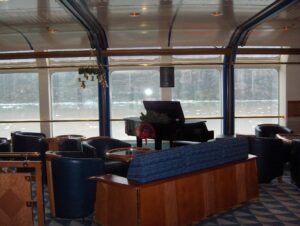
Today, we were to expect two things: the Skua Glacier in the morning (check), and entry into the Strait of Magellan about 5:30 in the evening. We should wake up on Wednesday in Punta Arenas, he advised.
What do you know about the Strait of Magellan? You probably remember from your social studies and geography classes that Mr Magellan came across a more sheltered body of water at the tip of South America than what the ships would have to endure by going all the way around the outer islands – a sort of nature-made Panama Canal. However, many of the largest sailing ships could not maneuver in the narrower, less windy waters. The rugged, mountainous area through which Estrecho de Magallenes passes, remote from the rest of the country, is called Magallenes (Mah-za-yan-es, for the Spanish sound).
I can see this on my map: Cabo Froward, in the Strait, is, officially, the Southernmost Point on the South American mainland. We’re due to pass that spot around 3 AM tomorrow morning. All the other famous markers are on islands!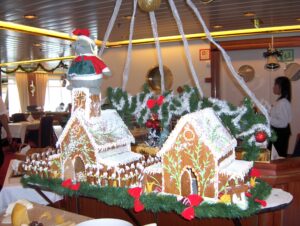
Other items fitted around Breakfast, Lunch, and Dinner today:
- 10:30 Penguins: Those from the Other Side
- 15:00 Krill and the Antarctic Food Chain
- 16:30 A Brief History of Antarctic Exploration 1772-2003
- 21:00 Film: On the Icy Edge of the World
I say mate, me brain is get-in a bit wrinkled, now!
» posted on Saturday, December 19th, 2020 by Linda Lou Burton
South Pole Santa Comes by Boat
Christmas in Antarctica originally posted by Linda Lou Burton December 19, 2005 from Puerto Eden, Chile – Puerto Eden was the featured stop for Monday, according to the script. Located on Wellington Island at Latitude 49 (Seattle is 47), Puerto Eden has only 160 residents. We were told two things at the evening briefing the night before.
One, we would cross the Gulf of Sorrows, Golfo de Penas, beginning at 9 PM, going out into open waters. It will be rough, we were warned. Take your seasickness pills early on. We’ll be into calm waters again around 5 AM.
 Two, we’d have the chance to go ashore at Puerto Eden, walk the wooden boardwalk, and buy a few souvenirs from the locals. The shore trip would be in PolarCirkel boats, and the boats would return with the children of the village. They were coming for a Christmas party with the Captain! Pizza would be served, with ice cream for dessert. Presents were waiting, too.
Two, we’d have the chance to go ashore at Puerto Eden, walk the wooden boardwalk, and buy a few souvenirs from the locals. The shore trip would be in PolarCirkel boats, and the boats would return with the children of the village. They were coming for a Christmas party with the Captain! Pizza would be served, with ice cream for dessert. Presents were waiting, too.
The rolling movement of the ship didn’t bother me, but the creaking noises did. I felt a bit queasy around midnight, and donned the wristbands-with-a-button that promised acupressure relief. I don’t know if they worked or if I just didn’t get seasick. I woke when we hit the calm waters, and it suddenly was quiet. Ah! I thought, I’m ready for breakfast.
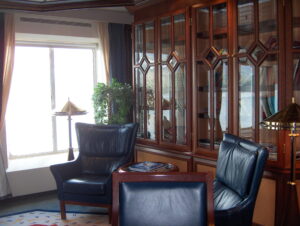 The buffet was huge; familiar eggs and ham and potatoes and breads and unfamiliar Norwegian dishes with fish as a starting point. My tablemates were chatty, with no one confessing to seasickness. In the library, aka bibliotek, while reading the BBC morning news, I fell asleep, sitting upright in a Norwegian blue leather chair in front of a picture window filled with Chilean fjords. It all seemed normal.
The buffet was huge; familiar eggs and ham and potatoes and breads and unfamiliar Norwegian dishes with fish as a starting point. My tablemates were chatty, with no one confessing to seasickness. In the library, aka bibliotek, while reading the BBC morning news, I fell asleep, sitting upright in a Norwegian blue leather chair in front of a picture window filled with Chilean fjords. It all seemed normal.
I skipped the morning lecture, Comorants: the Untold Story, but I photographed the remains of the Captain Leonidas, wrecked on the Cotopaxi Bank in 1957 (these were program events). 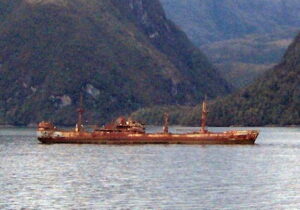 It was a rusty old ship, looking perfectly afloat, but going nowhere. Story is the Chilean pilot stepped away from the helm to eat lunch. A few minutes later, he heard a crashing noise, the claxons sounded, and as he rushed back to the bridge, he found the crew waiting at the lifeboats with their suitcases packed. The insurance claim was not paid.
It was a rusty old ship, looking perfectly afloat, but going nowhere. Story is the Chilean pilot stepped away from the helm to eat lunch. A few minutes later, he heard a crashing noise, the claxons sounded, and as he rushed back to the bridge, he found the crew waiting at the lifeboats with their suitcases packed. The insurance claim was not paid.
I sat in the Torghatten Salong for the rest of the morning, the gorgeous glass-enclosed lounge on Deck 7, watching the scenery as we passed through the treacherous Angostura Ingelesa (English Narrows). They made much of the fact that the current there is so strong no ship can pass through (by order of the Chilean government) except at slack tide. I assume our pilot was right on time; the waters were calm as glass and we were entertained by steamer ducks fluttering into takeoff, and otters swimming alongside.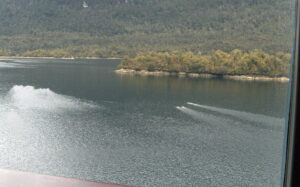
Lunch buffet (more fish), then Puerto Eden came into view, 20 buildings in bright reds and blues and yellows decorating the hills. Our groups were instructed to go to Deck 2 for boarding the PolarCirkels. My Dutch friend Will spotted me on the deck with my camcorder. “Go down to Deck 2,” he said, “I will help you get to your boat.”
 “I’m staying here,” I said. “I’m resting today.” Will went away, and I went downstairs. What I really wanted to do was to see the children!
“I’m staying here,” I said. “I’m resting today.” Will went away, and I went downstairs. What I really wanted to do was to see the children!
We had a pizza party with the beautiful children of Puerto Eden, a little town nestled between the mountains and the sea, with no roads in, no people nearby, and no industry of any kind.
Here, Santa comes by boat.


